How to clean the joints between tiles in the kitchen?
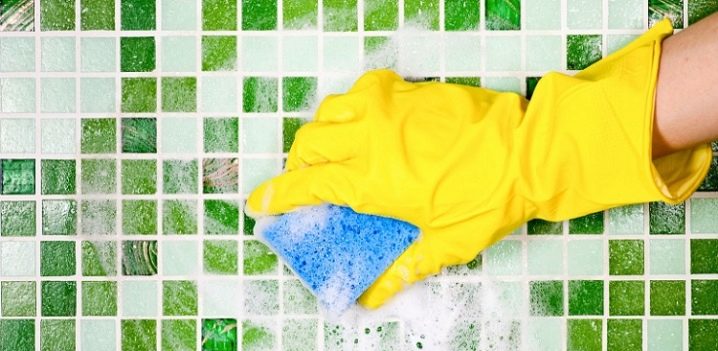
It is not in vain that tiles or ceramic tiles are chosen for the kitchen - in a room where greasy splashes are regularly scattered, these materials are indispensable. But if the hostess, for some reason, does not have time to immediately remove the pollution, then small particles of fat freeze, clog into the seams of the tile covering. To clean the joints qualitatively, you will need strong household chemicals or proven folk remedies.
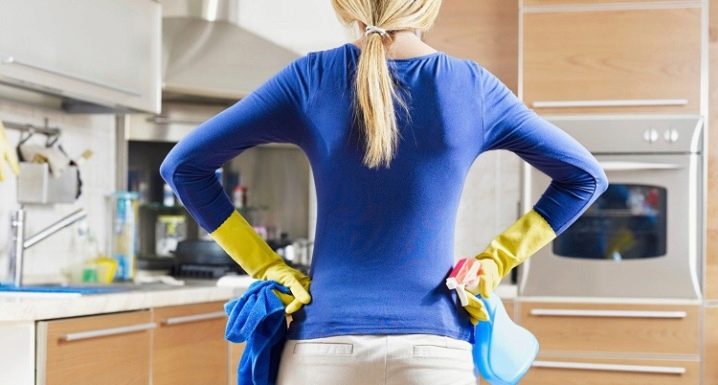
How to clean properly
Joints on a tiled backsplash or ceramic floor tiles require special treatment. Even if you quickly wipe the tiles with a regular wet cloth, grease and dirt often remain in the joints. Quality surface treatment requires care and consistency.
- To clean tile or ceramic tiles well, without missing a single seam, use special brushes or sponges that can effectively remove dirt without the risk of damaging the surface. Even if the joints are heavily soiled, metal products cannot be used. Such sponges will spoil the appearance of the finish.
- It is necessary to wipe the tiles after each cooking. Fresh drops of fat are easier to remove than old ones.
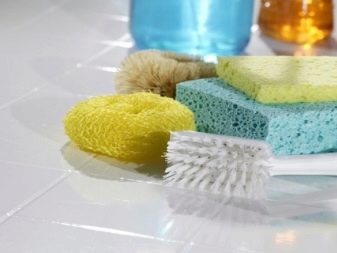
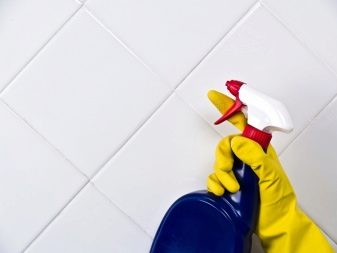
- Before using the detergent, it is advisable to heat it up. Stains from kitchen tiles will come off more quickly, and it won't take a lot of effort to scrub the joints.
- With the help of a special device, you can spray the coating with steam. It will soften stubborn dirt.
- When washing, you should wear household rubber gloves. They will protect the skin from the effects of aggressive substances.
- Cleaning of dirt on the kitchen wall, lined with tiles, and the joints between the tiles should be started from the bottom, and wiping of the washed surface - from the upper rows of the coating.
- To quickly wipe away grease and fungus between the tiles, you should arm yourself with a toothbrush.


Features of the use of household chemicals
When choosing a chemistry, you need to carefully study the instructions for using a particular product. Not all substances from the industrial arsenal of gels, liquids and powders are suitable for putting the tiles in order.
- Powders, despite their good penetration into the joints, damage the surface of the tiles themselves.
- Acidic chemicals will damage tile joints if they are not coated with epoxy paint.
- It is more profitable to purchase spray products, since they are consumed more slowly than gels and liquids.
- Compositions for windows and dishes are suitable for cleaning tiles and ceramic tiles.
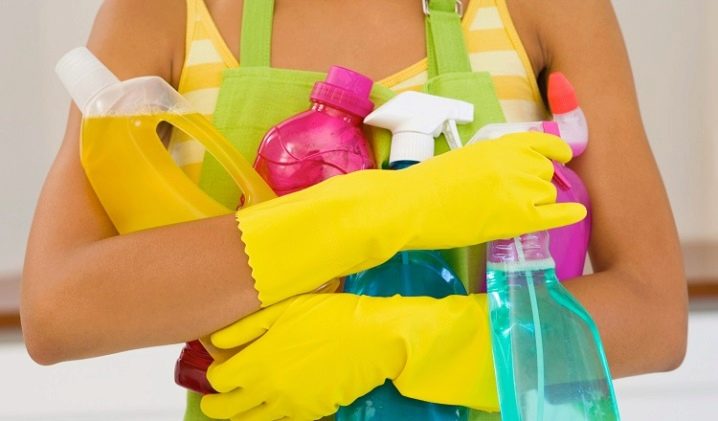
The use of improvised means
In addition to store chemistry, others made from substances and products available in the kitchen are used to clean the seams of tiles: soda, ammonia, vinegar, citric acid.
Soda and compositions based on it
Baking soda is great for cleaning seams. In 1 liter of water, 3 tablespoons of the substance are diluted. This liquid is used to wipe the tiles and joints using a sponge. Soda water makes the spaces between tiles lighter. After completing the cleaning, it remains to remove the stains with a damp cloth. If the joints are very dark, the baking soda can be combined with a substance containing chlorine. For example, use laundry bleach or washbasin and toilet cleaner: Domestos, Sif, or the like.
The bleach is combined with baking soda to form a paste.With this tool, the seams are treated so that there are no unworked areas left - if you miss something, then stains will remain on the floor or wall. The paste should dry completely. Wash it off with a brush and water. You can use such a tool only if the grout at the joints between the tiles is white. At colored joints, even very light ones, such compositions cannot be used - it is easy to spoil the appearance of the coating.
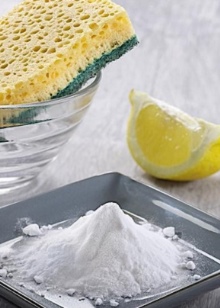
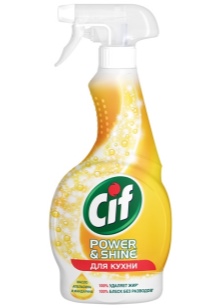
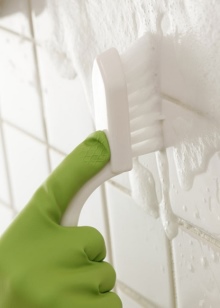
When tidying up the tiles, open the window to the kitchen and close the door at the same time so that the pungent smell of chlorine does not spread throughout the apartment. A mixture of soda and hydrogen peroxide will help to remove dirt from tiles and seams. For half a glass of sodium bicarbonate, take 70 milliliters of peroxide, add a little dishwashing gel or liquid soap. The mixture should be like porridge in consistency. It is distributed over the tiles, wait 10 minutes, and then washed off, wiping the seams well with a sponge.
To wash tiles and joints from fat, soda and vinegar are used together. Sodium bicarbonate is diluted with water to form a paste and spread on a tile, well processing inter-seam strips. Vinegar is then applied with a spray bottle. With this combination of substances, fat comes off more easily.

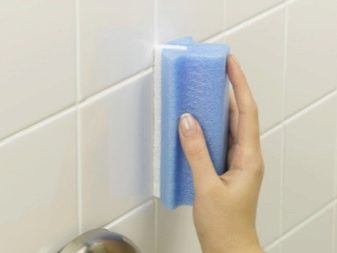
Lemon and citric acid
If the joints are covered with epoxy paint, lemon can be used. The fruit must be cut into slices and the surface of the tile or ceramic tile must be processed, as well as the joints between the plane elements. After processing, wait a few minutes for the acid to eat away at the fat, after which it remains to remove the remaining dirt. Citric acid can be used in the same way. It is enough to dilute a tablespoon of the substance in hot water, soak the joints and tiles with the liquid, and rinse off with water after 10-15 minutes.
An effective remedy is citric acid mixed with soda and starch. For 1 part of the acid, you need to take 2 parts of soda and 1 part of starch. Mix into a homogeneous mass, spread evenly over the tile with a sponge. To be sure, leave it on the tile for half an hour. Then rinse with water and wipe the surface.
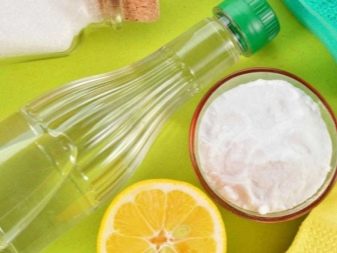

Ammonia
To clean tile and ceramic tiles, ammonia is often used. The sponge is moistened in it and passed along all the seams.
You can do otherwise: dilute 120 milliliters of ammonia in 4 liters of water and spray it onto the surface from a spray bottle. Rinse off after 15 minutes. The tiles will shine with gloss and cleanliness.

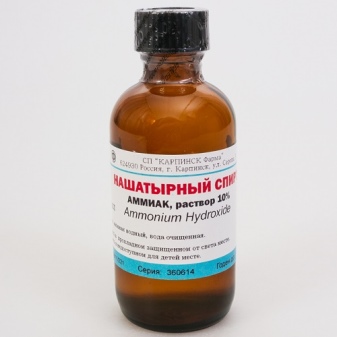
Mustard
It is advised to use dry mustard as a mushy cleaning mass. It is diluted to the appropriate type of sauce and applied to the seams and the surface of the tile. After cleaning with this product, the kitchen shines with cleanliness.
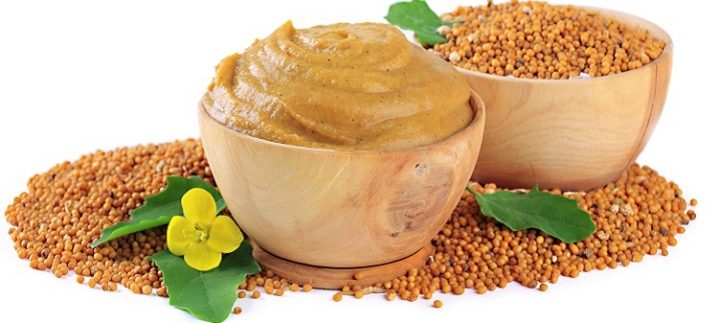
Vinegar based products
If you use a mixture of vinegar, borax and ammonia, you can not only get rid of grease in the seams and on the surface of the tile, but also not make stains on the gloss. In 4 liters of water, dilute 100 milliliters of vinegar, the same amount of alcohol and 4 tablespoons of borax. It is necessary to treat the tiles with this liquid and rinse thoroughly by wiping with a clean cloth.
In some cases, vinegar is mixed with clay that has a uniform powdery structure. It is necessary to ensure that there is no admixture of small stones or debris in the clay that can scratch the surface. For 5 tablespoons of clay, there should be 2 tablespoons of vinegar. Tiles are treated with this composition, and then thoroughly wiped.

Quick cleaners
So that general cleaning in the kitchen had to be arranged only in exceptional cases, it is good to use means of "instant action on the seams" during daily cleaning of the tiles. After finishing cooking, it is enough to apply dish gel on the sponge, foam, process the surface, and then rinse. A sponge with a hard structure is suitable for removing grease in the seams. A solution of laundry soap will help to rid the tiles and the seams between them from traces of fresh greasy splashes. They wipe the surface, pressing forcefully on the most dirty places.
Recipes for cleaning tiles and joints between tiles are varied. Among them, you can choose the most suitable for a particular case, depending on the characteristics of the tile and tile joints. At the same time, it is possible to minimize the time spent on surface treatment, as well as optimize the costs of substances that make up the cleaning agents.
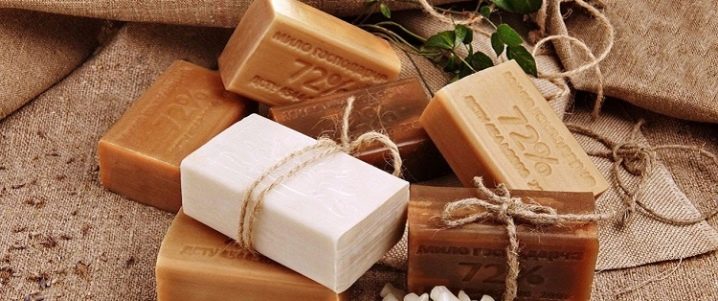
In the next video, you will find 10 ways to clean tile joints.













The comment was sent successfully.